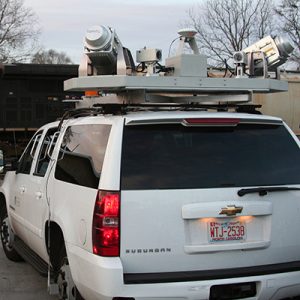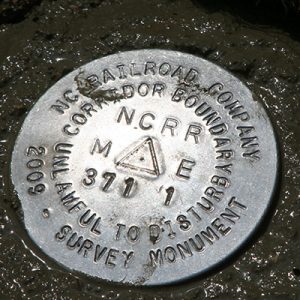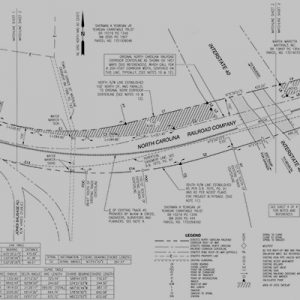There are more than 9,000 properties that adjoin the 317-mile-long (with more than 600 miles of boundary line) NCRR corridor. NCRR works closely with surveyors to assist in dispensing the most accurate information about the NCRR corridor. The following resources may aid surveyors in their work adjacent to the North Carolina Railroad:
The North Carolina Railroad Company Charter (Charlotte to Goldsboro): Pertinent sections are 1, 6, 17 and 25-31. Recommended reference language: “See Charter of The North Carolina Railroad Company 1848 – 49, N.C. Laws CH LXXXII (January 27, 1849) incorporating the North Carolina Railroad Company.”
The Atlantic and North Carolina Railroad Company Charter (Goldsboro to Morehead City): Pertinent sections are 1, 16, 23 and 25-31. Recommended reference language: “See Charter of The Atlantic and North Carolina Railroad Company 1852, N.C. Laws CH CXXXVI (December 27, 1852) Incorporating the Atlantic and North Carolina Railroad Company.”
Property maps of the North Carolina Railroad (circa 1850 – 1851) show the location, extent and individual property owners from which NCRR acquired land. Recommended language when referencing these maps: “Property Maps of the North Carolina Railroad Company Prepared in 1851 Under the Direction of Walter Gwynn, Chief Engineer, Showing Centerline Information and a 200-Foot Wide Corridor, Typical”.
NCRR can provide guidance on researching deeds for the railroad, which are public record and recorded in local register of deed’s offices. However, due to inconsistent indexing and their age they can sometimes be difficult to locate. In addition to deeds on file, research can often extend to records on file with the County Clerk of Court’s office and the North Carolina State Archives.
Additionally, NCRR is working with communities along the NCRR line to verify the location of the historic corridor to ensure this information is modernized and included in the appropriate databases.
For assistance identifying a railroad that is not owned by NCRR, access the Federal Railroad Administration (FRA) Geographic Information System (GIS). The FRA GIS identifies railroad owner/operator, as well as specific crossing and milepost numbers in order to accurately communicate your area of interest to railroad representatives when requesting property information, such as Valuation Maps.
 Historic Centerline Survey – NCRR worked with contractors to survey the historic centerline of the railroad corridor. This project was a combination of LiDAR data collection and conventional (GPS) surveying to locate existing tracks as well as portions of historic centerline that no longer coincide with existing tracks. The end result is a comprehensive centerline survey that serves as the basis for the NCRR corridor location (for typical 200’ wide corridor). NCRR recorded surveys for sections of corridor that has centerline that no longer coincides with existing track. These surveys would be available in the corresponding county’s register of deed’s office. For sections of corridor centerline that have never been purposely re-engineered (still in original location), NCRR can provide centerline data in CAD format that contains coordinate geometry. In some cases, the centerline survey information allows surveyors to recreate the railroad corridor without having to set foot in the corridor.
Historic Centerline Survey – NCRR worked with contractors to survey the historic centerline of the railroad corridor. This project was a combination of LiDAR data collection and conventional (GPS) surveying to locate existing tracks as well as portions of historic centerline that no longer coincide with existing tracks. The end result is a comprehensive centerline survey that serves as the basis for the NCRR corridor location (for typical 200’ wide corridor). NCRR recorded surveys for sections of corridor that has centerline that no longer coincides with existing track. These surveys would be available in the corresponding county’s register of deed’s office. For sections of corridor centerline that have never been purposely re-engineered (still in original location), NCRR can provide centerline data in CAD format that contains coordinate geometry. In some cases, the centerline survey information allows surveyors to recreate the railroad corridor without having to set foot in the corridor.
 Monumentation – In addition to the centerline survey, NCRR is having geodetic monumentation installed on either side of the 200-feet-wide corridor at approximately ½ mile increments (where feasible). These monuments will be established by NOAA NGS-58 guidelines for 2 cm accuracies, or “Bluebooked”. Although these monuments will not be placed at meaningful points in the corridor geometry (point of curve, etc.) they will help supplant older monumentation that is inside of the railroad operations safety envelope which is often difficult to recover without trespassing or applying for a right of entry permit. NCRR is working closely with contractors and the NC Geodetic Survey to accomplish this project, which will be a useful addition to an already reliable control network in North Carolina. When published, these monuments will be available through the NGS Database as well as the NCGS Database.
Monumentation – In addition to the centerline survey, NCRR is having geodetic monumentation installed on either side of the 200-feet-wide corridor at approximately ½ mile increments (where feasible). These monuments will be established by NOAA NGS-58 guidelines for 2 cm accuracies, or “Bluebooked”. Although these monuments will not be placed at meaningful points in the corridor geometry (point of curve, etc.) they will help supplant older monumentation that is inside of the railroad operations safety envelope which is often difficult to recover without trespassing or applying for a right of entry permit. NCRR is working closely with contractors and the NC Geodetic Survey to accomplish this project, which will be a useful addition to an already reliable control network in North Carolina. When published, these monuments will be available through the NGS Database as well as the NCGS Database.
 Boundary Survey Modernization – There are areas of the NCRR corridor that are not a uniform 200-feet-wide. These areas consist of old depot lots, track straightening projects, and some urban areas in cities such as Raleigh, Salisbury, Kinston, and New Bern. In these areas, NCRR is making the effort to modernize the survey record and have boundary surveys produced. In many instances, in depth title research is required due to the complexity that often accompanies property boundary survey work along a railroad. NCRR is recording these new surveys in their respective county’s register of deed’s offices so that future generations will have an accurate record of the property.
Boundary Survey Modernization – There are areas of the NCRR corridor that are not a uniform 200-feet-wide. These areas consist of old depot lots, track straightening projects, and some urban areas in cities such as Raleigh, Salisbury, Kinston, and New Bern. In these areas, NCRR is making the effort to modernize the survey record and have boundary surveys produced. In many instances, in depth title research is required due to the complexity that often accompanies property boundary survey work along a railroad. NCRR is recording these new surveys in their respective county’s register of deed’s offices so that future generations will have an accurate record of the property.
GIS Data Disclosure Agreement for Engineering and Surveying Professionals
“Mapping the Centerline,” Professional Surveyor Magazine, March 2014
“Railroad Right of Entry: It’s the Right Thing to Do,” NCSS Tarheel Surveyor, Fall 2011
“History and Technology Merge Geospatially,” Professional Surveyor Magazine, July 2010